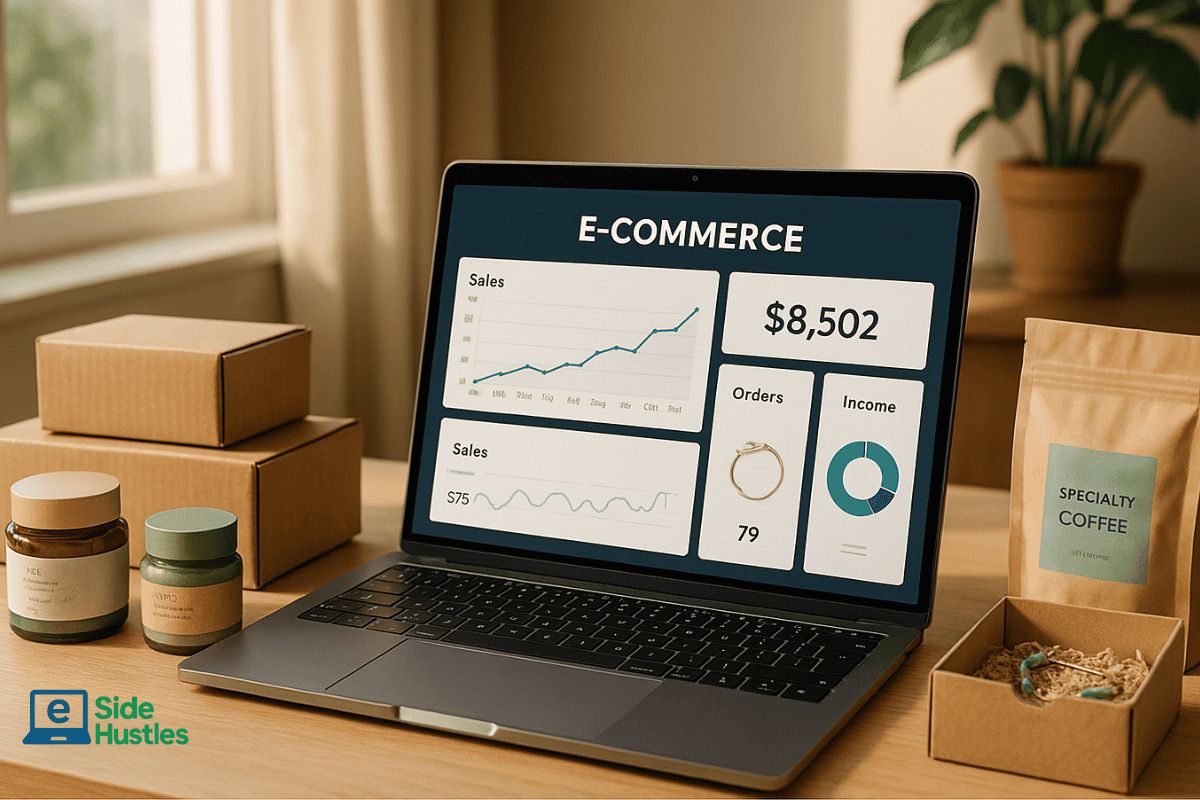
Automated dropshipping uses AI to handle repetitive tasks like inventory, order fulfillment, and supplier communication. This saves time, reduces errors, and boosts profits - some businesses report profits exceeding $2,000 per transaction compared to the traditional average of $2 per sale.
Key Benefits of Automated Dropshipping:
- Faster Shipping: 3-5 days vs. 2-4 weeks in traditional methods.
- Higher ROAS (Return on Ad Spend): 10-20× vs. 2-3×.
- Automation: Handles 90% of manual tasks, from inventory updates to customer service.
- Scalability: Perfect for targeting niche markets like phone accessories or eco-friendly products.
Tools You Need:
- AutoDS ($24/month): Automates product sourcing, fulfillment, and customer service.
- DSers (Free to $49.99/month): Streamlines order processing.
- Inventory Source ($99-$150/month): Keeps inventory synced in real-time.
Top Niches for 2025:
- Car Accessories: $530B market, 5.8% annual growth.
- Phone Accessories: $22B market, 8.3% annual growth.
- Baby Care Products: $88.7B market, 6.4% annual growth.
Quick Comparison: Traditional vs. Automated Dropshipping
| Feature | Traditional | Automated |
|---|---|---|
| Shipping Time | 2–4 weeks | 3–5 days |
| Profit Per Sale | ~$2 | $2,000+ |
| ROAS | 2–3× | 10–20× |
| Order Processing | Manual | Fully automated |
| Supplier Communication | Manual | AI-powered automation |
Finding Your Niche Market
Niche Market Research Methods
To discover a profitable niche, you need to do some digging. Start by looking at broad, expanding industries like the massive $4.32 trillion e-commerce sector.
When narrowing down potential niches, keep an eye on these essential factors:
- Market Size and Growth: A good niche shows consistent growth. Take the home improvement market, for example - it’s expected to hit $805.75 billion by 2026, growing at an annual rate of 8.5%. Within this, specialized areas like smart home installations and eco-friendly renovations are gaining traction.
- Consumer Behavior Analysis: Pay attention to what customers care about. For instance, 74% of consumers value transparency, and 58% are willing to pay more for sustainable products. These trends can help you zero in on niches with strong demand and loyal buyers.
Top Niches for 2025
By applying these research methods, several niches stand out as promising opportunities for 2025:
| Niche Market | Market Size | Growth Rate |
|---|---|---|
| Car Accessories | $530 billion | 5.8% annually |
| Home Appliances | $670 billion | – |
| Baby Care Products | $88.7 billion | 6.4% annually |
| Phone Accessories | $22 billion | 8.3% annually |
Another noteworthy area is home office equipment, valued at $18 billion, which continues to thrive as remote work remains a significant trend.
Market Research Tools
Using the right tools is crucial for effective market research. Here are some options to consider:
-
Google Tools Suite:
- Google Trends helps you track interest levels over time.
- Google Keyword Planner provides insights into search volumes for specific terms.
- Google Shopping allows you to compare pricing strategies.
- Professional Research Platforms: Tools like SaleSource analyze billions of Shopify data points to provide detailed insights. Monthly subscriptions range from $89 to $999.
For deeper market analysis, don’t overlook these critical steps:
- Competition Analysis: Study the top-ranking websites in your niche and evaluate their customer experience.
- Supplier Reliability: Use resources like Better Business Bureau ratings to confirm supplier credibility.
- Profit Margins: Focus on niches with healthy margins. For example, consumer electronics often yield an average margin of 29%.
Setting Up Your Automation System
Platform Selection Guide
Picking the right e-commerce platform is a key step in setting up a successful automated dropshipping business. Here’s a breakdown of some popular platforms and their automation capabilities:
| Platform | Monthly Cost | Key Automation Features | Best For |
|---|---|---|---|
| Shopify | $19-$299 | Built-in flow automation, app integration, inventory sync | Beginners and growing businesses |
| WooCommerce | $120/year* | Custom plugins, limitless customization options | Tech-savvy users |
| Wix | $23-$49 | Native dropshipping tools, automated email marketing | Visual designers |
*Base hosting cost, excludes premium plugins.
Once you’ve chosen a platform, the next step is integrating tools that will handle repetitive tasks and streamline your workflow.
Required Automation Tools
Here are some must-have tools to make your operations run smoothly:
Product Management: AutoDS ($24/month) is a go-to solution for product automation. It handles tasks like auto-ordering, product importing, and customer service. As Nahar Geva, CEO of AutoDS, explains:
"I manage my full automation, auto ordering, importing items, customer service, and everything else with AutoDS."
Order Processing: DSers, an official AliExpress partner, offers flexible pricing plans:
- Basic: Free (manual ordering)
- Advanced: $19.99/month (bulk order processing)
- Pro: $49.99/month (unlimited orders)
Inventory Synchronization: Inventory Source ($99-$150/month) ensures real-time stock updates across suppliers. This minimizes errors like overselling and keeps your inventory accurate.
With these tools in place, you can automate your routine tasks and focus on scaling your business.
Daily Operations Automation
Automation can simplify your daily operations, saving time and reducing errors. Here’s how you can automate key areas:
1. Inventory Management
- Regularly update stock levels (every 30 minutes).
- Adjust pricing based on competitor data.
- Remove out-of-stock items promptly.
- Set up alerts for low-stock items.
2. Order Processing
- Automate order verification.
- Notify suppliers automatically after orders are placed.
- Update tracking numbers without manual input.
- Streamline customer communication about orders.
Studies show that automation has boosted productivity for 66% of e-commerce businesses.
3. Customer Service
- Deploy chatbots for instant responses.
- Set up email autoresponders for common inquiries.
- Automate return and refund processing.
- Keep customers informed with automated order status updates.
Automated customer service systems have been shown to increase repeat purchases by 93%.
Marketing and Growth Tactics
Niche Market Promotion
By 2025, niche marketing requires laser-focused strategies. Research shows that audiences in niche markets spend 4.7 times more time engaging with specialized content compared to broader, general content. This means creating content tailored to specific interests is no longer optional - it's a must.
| Marketing Channel | Performance Metric | Best Practices |
|---|---|---|
| Micro-Influencers | 60% higher engagement | Collaborate with niche influencers (5K–50K followers) who resonate with your target audience. |
| Email Marketing | 50% higher click-through rate (CTR) | Personalize campaigns by segmenting based on purchase history and user interests. |
| Social Commerce | 3.8× higher conversion rate | Make use of native shopping features on platforms like Instagram and TikTok. |
| Content Marketing | 71% higher retention rate | Develop educational content that solves specific problems for your audience. |
Sofia Hernandez, TikTok's Global Head of Business Marketing, sums it up perfectly:
"The brands that harness these insights can forge deeper, more meaningful relationships with their audiences".
By focusing on these strategies, brands can position themselves to scale effectively, especially when paired with automation tools.
Growth Through Automation
Targeted marketing is just the beginning - automation is the key to scaling these efforts. Businesses that integrate AI tools into their operations have reported an average 28% boost in profitability. Automation allows companies to streamline day-to-day tasks while driving growth at scale.
Here are three automation strategies delivering results:
-
Data-Driven Product Selection
Use AI to analyze market trends and pinpoint products with the highest potential for success. This ensures you're always ahead of demand. -
Personalized Customer Experiences
AI-powered personalization across channels can significantly improve customer engagement. Companies using this approach have seen conversion rates jump by 63%. -
Multi-Channel Expansion
Automate your presence across multiple platforms while maintaining consistent messaging. Brands taking this route have achieved 60% higher international market penetration rates.
Another powerful growth tactic? Building active communities. Businesses with engaged communities see customer lifetime values 2.3 times higher than those without. These communities not only drive loyalty but also create a sustainable foundation for long-term growth.
sbb-itb-fd652cc
How To Automate Your Dropshipping Store | Step By Step
Next Steps for Success
The landscape of dropshipping in 2025 demands a blend of automation and personalization. With the market expected to hit $2,241.76 billion by 2033, staying ahead means fine-tuning key metrics while tapping into emerging technologies. By building on current marketing and automation strategies, these actionable steps can help you move forward effectively.
| Success Pillar | Key Metrics | Implementation Strategy |
|---|---|---|
| Customer Value | CLV, Gross Margin | Personalized automation and review management |
| Cost Efficiency | CAC, Cart Abandonment | AI-powered optimization and multi-channel tracking |
| Growth Potential | Conversion Rate, AOV | Integration of voice and visual search features |
To ensure consistent progress, focus on these core areas:
Embrace AI-Powered Personalization
AI-driven personalization is a game-changer. By using automated storefronts that adapt to customer behavior, you can cut costs while delivering a better shopping experience. This approach not only enhances customer satisfaction but also boosts retention.
Optimize for Next-Gen Search
As consumer behavior shifts, adapting to new search trends is crucial. Optimize your product listings for natural language searches and integrate visual search tools. These updates align your store with how customers are now looking for products, ensuring you remain competitive.
Sustainability Integration
Sustainability is no longer optional. Searches for eco-friendly products have grown by 71% over the past five years. Partnering with local suppliers can help reduce shipping times and minimize environmental impact. Some areas where this strategy thrives include:
- Home decor: Focus on eco-friendly materials.
- Health and beauty: Highlight natural and organic products.
- Baby products: Offer items made from non-toxic materials.
Performance Tracking
Keep an eye on the numbers. Use analytics tools to monitor key metrics like profit margins (aiming for 15-20%) and marketing ROI. Multi-touch attribution analysis can provide deeper insights into what's working. Regularly reviewing these metrics allows you to address weak spots and maintain steady growth.
By prioritizing these steps, you'll be better equipped to navigate the evolving dropshipping landscape and achieve long-term success.
FAQs
What are the key differences between automated dropshipping and traditional methods when it comes to profitability and efficiency?
Automated dropshipping has transformed how businesses operate, offering a noticeable boost in both profits and efficiency compared to older methods. By automating repetitive tasks like inventory tracking, order processing, and even customer service, companies can minimize mistakes, cut down on operating expenses, and manage larger order volumes without the need for extensive manual work.
When it comes to profits, automated dropshipping often leads to higher margins. In fact, some businesses report profit margins exceeding 20%, depending on the niche they’re in. Plus, advanced tools and AI-driven systems play a key role in fine-tuning customer acquisition and targeting strategies, making it easier to grow and maintain success over time.
What should I consider when choosing a niche market for automated dropshipping in 2025?
When selecting a niche market for automated dropshipping in 2025, prioritize market demand, competition levels, and product quality. Aim for niches where consumer interest is on the rise but haven’t become overly crowded. This approach can give you a better shot at standing out and succeeding. To spot these opportunities, consider using tools like trend analysis platforms or conducting thorough market research.
Equally important is partnering with dependable suppliers to maintain consistent product quality and efficient inventory management. Reliable suppliers not only enhance customer satisfaction but also help build trust, leading to repeat business. By carefully weighing these factors, you’ll lay the groundwork for a thriving dropshipping business in your chosen niche.
What are the essential tools and platforms for starting an automated dropshipping business in 2025?
To kick off a thriving automated dropshipping business in 2025, you’ll need the right tools and platforms to keep things running smoothly and efficiently. Shopify is a go-to option for creating your online store, thanks to its seamless integrations tailored for dropshipping. Tools like DSers make managing bulk orders from AliExpress a breeze, while Spocket connects you to suppliers in the US and EU, ensuring quicker shipping times.
For supplier directories and market insights, SaleHoo is a helpful resource. On the product research front, tools like GemPages can assist in spotting trending products. Meanwhile, inventory management platforms such as Ordoro simplify stock tracking and shipping logistics. With these tools, you can save time, enhance customer experiences, and dedicate more energy to scaling your business.

